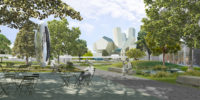“It all started with a very slow bartender at a gallery opening,” says composer Raphael Mostel of his longtime collaboration with architect Steven Holl. The two met about a decade ago while waiting in line for drinks at the opening of an appropriately inter- disciplinary event, a show featuring the work of composer John Cage and video artist Nam June Paik. Since then, the two have worked together, consulting with each other on myriad projects including one of Holl’s commissions, set to open later this year, a Maggie’s Centre at St. Bartholomew’s Hospital in London.
Mostel recalls discussing the project over dinner with Holl, who was “searching for a way to honor the history of the place.” Their conversation touched on topics such as the Guidonian hand (a medieval mnemonic that helped musicians learn to sight-sing) and neume notation (a predecessor to the five-line staff), “all of which Steven began sketching or noting in his sketchbook,” says Mostel. “That became the kernel for his magnificent realization of the project.”
Well known for his prolific architectural watercolor sketches, Holl’s creative process always begins on a 5-by-7-inch pad. “When I draw and paint, I connect the subjective and the objective. It’s a way of open thinking and free-feeling, and it’s unpredictable,” he says. “In order to get closer to a dreamlike subjectivity, I like to make these little drawings and paintings at dawn, before breakfast. There is a joy in this way of beginning.”
Holl values quick sketches for the experimentation they allow. “These subjective studies open paths to be tested in the studio.” More than 25,000 paintings in his firm archive testify to his dedication to the practice.
Similarly, Mostel ignites the creative spark and disrupts fallow periods through dogged perseverance. Polish composer Witold Lutosławski once told him, quoting writer Sławomir Mrożek, “Inspiration begins on page 60.” In Mostel’s own words, that advice means one shouldn’t wait for inspiration to strike. “Once you’re focused enough through working, it comes of its own accord.”
Along with Dimitra Tsachrelia, an associate in Holl’s firm, Holl and Mostel teach a series of studio classes at Columbia University called the Architectonics of Music. During the first weeks of the course, students select works of 20th-century composers and geometrically translate them into architectural designs. “It’s very different working with Steven as opposed to working with anybody else,” says Mostel. “There’s always a sense of play, as if the terms of the game can change on a dime. He’s constantly just turning the soil over, and you’re all of a sudden sowing a completely different crop.”









Post a comment to this article
Report Abusive Comment